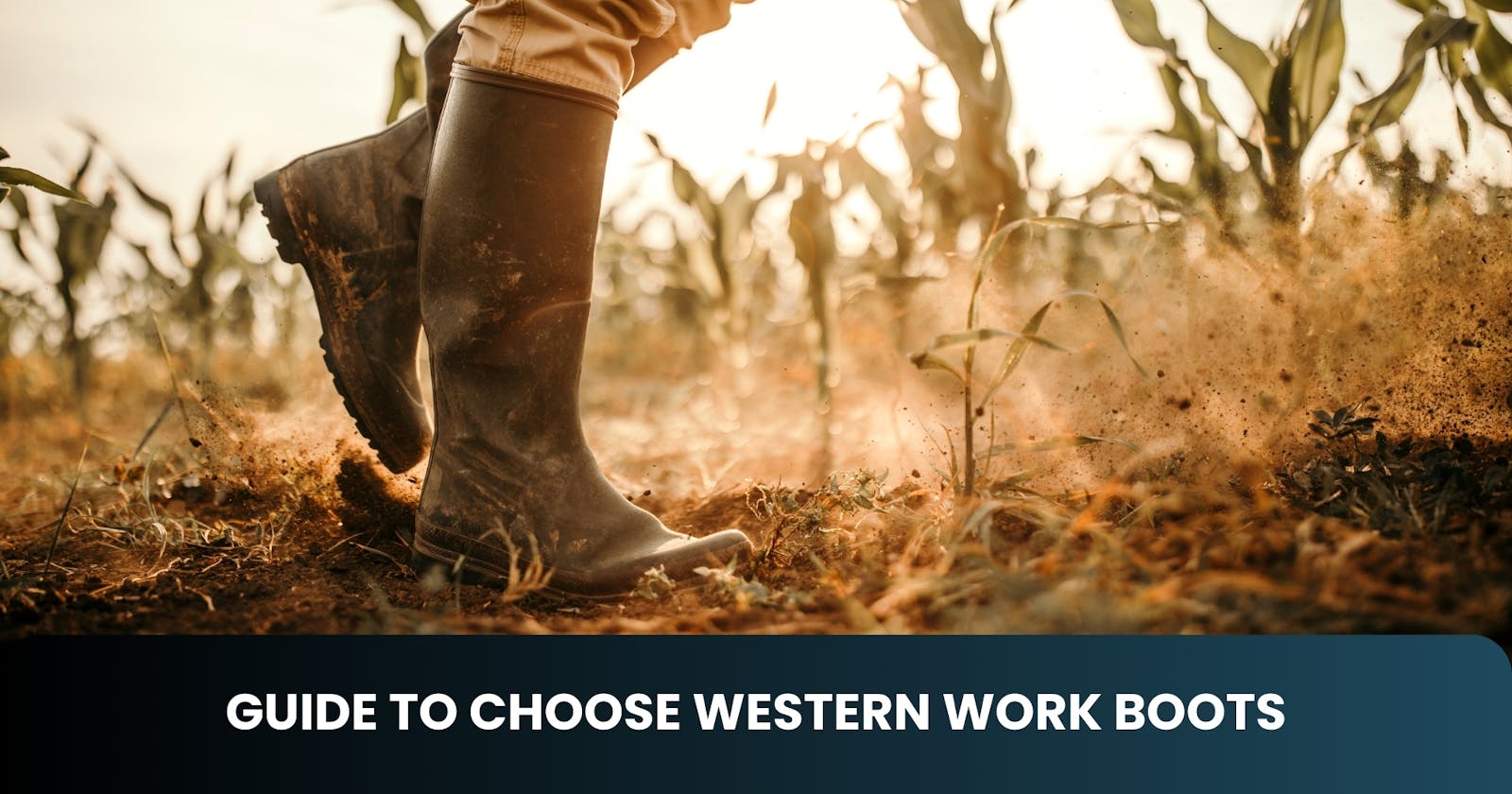Work boots are serious footwear. Although they are often purchased for the practical purpose of providing foot protection during long hours of labor, ranch work, or standing, Western work boots are versatile enough to be worn for more than just work. Finding the right pair of work boots can be a challenge, so we've compiled a guide to assist industrious cowboys and cowgirls through the selection process. Continue reading to discover more about Western work boots and how to select the ideal pair for your needs.
What to Look for in Western Work Boots
The type of work boots you require will vary based on the nature of your job. For example, cleaning a barn may necessitate a pair of leather work boots with a light tread, while operating heavy machinery may require safety-toe boots for added protection. Once you understand the crucial components and features of men's or women's work boots, you can make an informed decision that aligns with your specific requirements.
Outsole Materials Make a Difference
Most work boot outsoles, or soles, are specifically designed to meet particular requirements. For instance, work boots with robust tread and lugs provide the necessary grip for scaling ladders in a barn or on a construction site. Cowboys who work outdoors or on rugged terrain often require boots with a deeper tread and a higher heel to enhance traction and grip. Cowboy work boots with nonslip soles are particularly useful in garages or wet environments. Work boot outsoles typically come in one of three materials:
Polyvinyl chloride (PVC): These soles, made from vinyl, are oil- and abrasion-resistant, waterproof, and well-insulated, making them suitable for outdoor work in cold or rainy weather.
Thermo polyurethane (TPU): Lightweight and durable, TPU soles are ideal for hiking and rugged terrains. They are abrasion- and chemical-resistant, making them perfect for barn work.
Rubber: Rubber sole boots are ideal for construction, electrical, and manufacturing work. They are oil-, abrasion-, and slip-resistant. Thick rubber soles are difficult to penetrate, ensuring your work boots last for many years with proper care.
Pro Tip: Lightweight outsoles are ideal for jobs requiring flexibility, as they won't weigh you down. On the other hand, thick boot soles offer enhanced protection on rough terrain and rocky job sites, but they are heavier.
Leather Versus Synthetic Uppers and Shafts
Many Western work boot uppers and cowboy work boot shafts are crafted from leather, a material known for its durability, protective qualities, and longevity when properly maintained. Some manufacturers provide leather boots with a waterproof coating, and it is also possible to waterproof leather work boots at home.
Synthetic leather work boots are made from man-made materials such as polyester, nylon, acetate, latex, and Kevlar®. Synthetic materials can offer benefits like being lightweight, durable, breathable, and waterproof, but they generally don't last as long as leather.
Essential Work Boot Safety Features
Many employers require work boots with an ASTM (American Society for Testing and Materials) rating. This independent third-party organization tests work boots for slip, puncture, pressure, electrical, and impact resistance and then certifies them for safety. Slip-resistant soles have been tested and proven to perform well on wet, dry, and oily surfaces. Work boots with an Electrical-Hazard (EH) rating have nonconductive, shock-resistant soles and heels, protecting against electrocution up to 600 volts in a dry setting.
A work boot with a reinforced safety toe is essential when hauling, ranching, or working with heavy loads or equipment. Most work boots come with steel, aluminum, or composite safety toes.
Steel – Traditional material for reinforced safety boots; heavy, durable, and protective. Steel conducts both heat and cold so that feet can become uncomfortable in extreme temperatures.
Aluminum – Thicker than steel but lighter weight, offering protection in the heat or cold as they do not conduct temperature.
Composite – Made from a blend of carbon fiber, plastic, and Kevlar®, composite toe boots are tough, metal-free, and non-conductive.
Not all work boots include a safety toe; soft-toe work boots are flexible, lightweight, and perfect for low-hazard jobs that require support.
Choose Cushioned Insoles and Supportive Midsoles
The insole is the cushioned part under your foot that manages moisture and odor. Some Western work boot brands come with anti-fatigue insoles, but most are made of lightweight foam. Since insoles are usually removable, you can easily swap them out for a pair of sturdy boot insoles that offer extra cushioning, odor defense, or temperature control.
The midsole lies directly below the insole and offers support. The best shock-absorbing work boot midsoles are made of PU (polyurethane) or EVA (ethylene-vinyl acetate). PU midsoles are resilient, long-lasting, and thick. EVA midsoles are durable and lighter than PU but tend to compress over time.
Pro Tip: Wear work socks with your boots. Socks that are ribbed in the arches and thick in the heels and toes provide extra cushioning—especially helpful in a reinforced toe boot.
How to Prevent Sweaty Feet in Work Boots
One common concern regarding boots is how to prevent your feet from sweating while you work. To address this, consider work boots with a breathable mesh lining, which can effectively wick away moisture. Alternatively, you can opt for absorbent inserts that reduce both moisture and odor. Applying foot powders or antiperspirants before putting on your socks can also help. Additionally, choose boot socks made of polyester, merino wool, or other moisture-wicking fabrics, as cotton socks, while lightweight, are not as effective in this regard.
Pro Tip: Avoid cotton socks as they aren't moisture-wicking and may exacerbate sweating.
How to Choose Well-Fitting Western Work Boots
The key to finding the right work boots is getting the right fit. Start with your cowboy boot size as a guide, and try on a few pairs to find the best fit. You may need to go up or down a half size. When trying on work boots, wear the socks you'll typically use with them. Follow these guidelines to ensure the proper fit:
Toe: There should be about a half-inch of space between your toe and the front of the boot.
Heel: Your heel should not rub or slide against the back of the boot.
Sides: The work boots should fit snugly without causing tight pressure on the sides.
Walking: When walking, your feet and toes should not shift forward within the boots.
Finding the right fit is crucial for comfort and safety, so take the time to find a pair of work boots that fit well.
Name: Rod's Western Palace
Address: 3099 Silver Dr, Columbus, OH 43224
Phone No: (866) 326-1975

